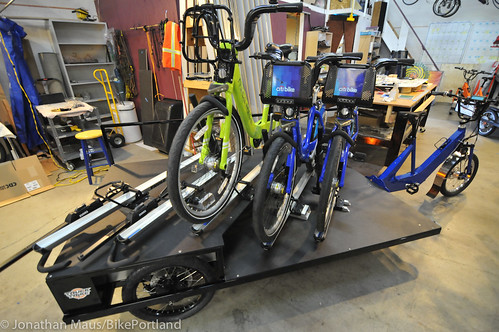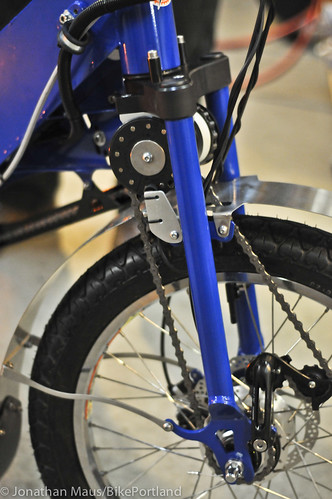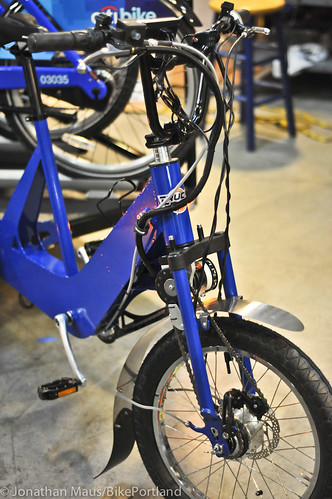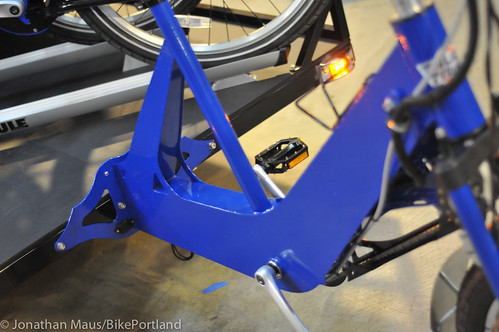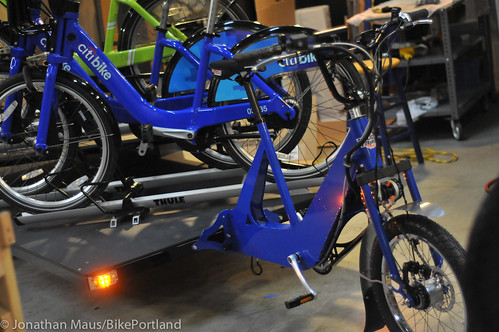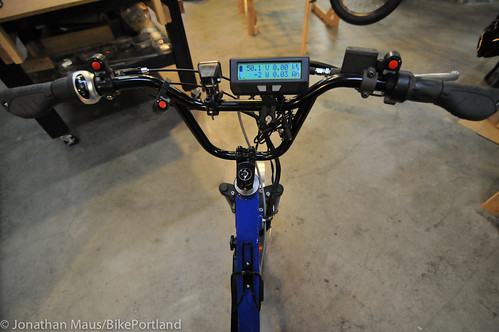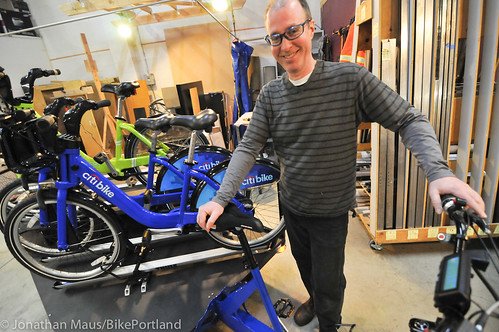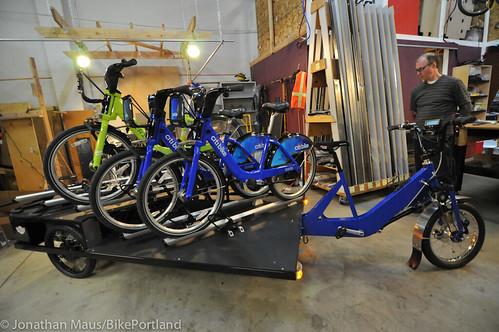
(Photos J. Maus/BikePortland)
When a local bike company toils on cool projects for many years, then finally breaks through to something big, we get really excited. Such is the case with Stites Design, the southeast Portland company that has sold a custom version of their electric-assist Truck Trike to Alta Bicycle Share for use in the Citi Bike bike share system in New York City.
Bill Stites has spent the last two decades building custom, one-off human-powered vehicles (and at least one artistic bike parking structure). About five years ago he started R & D on a cargo trike that had enough power and payload that it could legitimately replace a truck. He called it the “Trucker Trike” and we first reported on it in 2010 when he debuted it at the Pedal National Bicycle Show. A few months later we caught up with Bill and took a more in-depth look at his creation.
Since then, Stites’ business — and the trike — have gone through a lot of changes. He now has an equity investor, a full-time employee (mechanical engineer Brian Hall), and he’s got several trikes in use around the country (including one on the campus of UC Berkeley where it’s used in their recycling program). Since 2010, the trike has been refined and re-engineered in many significant ways and Stites told me at his shop this afternoon that they are now ready for mass production.
On Monday, the Truck Trike will be in the spotlight as Alta Bicycle Share hosts a media event and launch party prior to sending it off to New York City. As a new tool in the Citi Bike operational arsenal, the Truck Trike will focus on the task of rebalancing — which means it will ferry bicycles between kiosks so that bike share users won’t confront an empty (or full) stations. (For a look at how rebalancing is usually done, check out our behind-the-scenes visit to Capital Bikeshare in D.C.)
The Truck Trike has several advantages over the mid-sized “Sprinter” van currently used by New York City Bike Share employees. It has a much smaller footprint, which means it can roll in bike lanes when traffic backs up. With an operational speed of about 12-14 miles an hour, and the ability to use the carfree bikeways, the Truck Trike can potentially get around Manhattan at about twice the average speed of a truck or van (average traffic speed in Manhattan being about 7 mph). It also boasts a much narrower turning radius than a van. Stites says it can turn around within the width of a standard vehicle lane. It’s also, obviously, much more environmentally-friendly than a vehicle that burns fossil fuels. It’s cost effective too: At a price of about $8,000, a company could buy several of them for the price of one new van or truck.
The Truck Trike that will be used by Citi Bike is powered by two motors — the operator’s legs which power an 8-speed internal front hub, and a 500 watt electric battery that drives one of the rear wheels (a motor for the other rear wheel can be added if necessary, thus doubling the power). Because the rear wheels of the trike are driven independently by separate motors, there’s no pesky transmission system or chain-line that has to be considered. This lack of needing to connect the rear wheels to the cranks means Stites can create custom rear trailer designs.
In the case of the Citi Bike Truck Trike, they’ve designed a long (96-inches) and wide (54-inches) trailer with a low cargo bed to make it easy for workers to roll off the 42 pound bikes. The trailer can currently hold up to five bikes. That’s a load of just 210 pounds; child’s play for the Truck Trike which boasts a payload capacity of 600 pounds. The trike itself weights about 275 pounds.
The trike also comes with turn signals, running board lights, dual motorcycle rear disc-brakes, brake lights and a powerful headlight.
Check out a few more photos below…
Good luck Bill! We rooting for the trike to do great in New York City and hopefully orders start coming in from cities across the globe!





